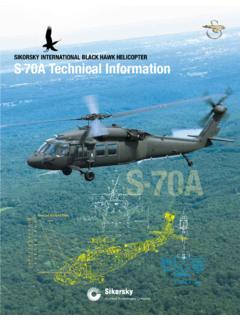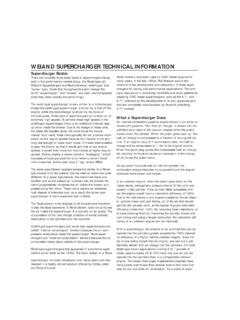Transcription of Pratt & Whitney R-2800 - aviatorsdatabase.com
1 1 Pratt & Whitney R-2800 Pratt & Whitney R-2800 The Pratt & Whitney R-2800 Double Wasp was an aircraft engine, and part of the long-lived Wasp family. It was a two-row, 18-cylinder, air-cooled radial design. Displacement was 2,804 cubic inches (46 liters); bore and stroke were " and 6". The R-2800 is considered one of the premier radial piston engines ever designed. It became legendary when used in several aircraft during World War II, notably the F4U Corsair, P-47 Thunderbolt, and the Grumman F6F Hellcat. During the war years, Pratt & Whitney were always coming up with new ideas to upgrade this already powerful workhorse, most notably water injection to give emergency power in combat.
2 After World War II, the engine was used in the Korean War, and surplus World War II aircraft powered with the Double-Wasp served with other countries well past the Korean War, some being retired as late as the latter part of the 1960s when the aircraft were replaced. The R-2800 also powered post-war propliners from Douglas, Lockheed and Martin. Today, more than 60 years after the first Double Wasp was built, it is still used in many restored vintage aircraft in air shows. Models R-2800 -9: 2,000 hp (1,491 kW) R-2800 -10W: 2,000 hp (1,491 kW) R-2800 -27: 2,000 hp (1,491 kW) R-2800 -31: 2,000 hp (1,491 kW) R-2800 -34W: 2,100 hp (1,567 kW) R-2800 -43: 2,000 hp (1,491 kW) R-2800 -54: 2,100 hp (1,567 kW) R-2800 -57C: 2,800 hp (2,090 kW) R-2800 -59: 2,300 hp (1700 kW) R-2800 -57C This is the engine specified for P-47M and P-47N.
3 The engine specs reveal a "C" crankcase with the Bendix Scintilla DF-18LN magneto. So, it should have the late-style barrel shaped/bolted gear reduction unit with two octagonal distributors (10:30 and 1:30 position) and a single dual magneto (at 12:00). The distribution harness was the square-section cast version. (Visually identical to the engine(s) in the F4U-4, F7F or F8F and some P-61C). The engine also used a single stage, single speed supercharger (due to the P-47's use of a turbocharger), and a downdraft Bendix/Stromberg carburetor sitting at the top of the auxiliary section. 2 Specifications ( R-2800 -54) General characteristics Type: 18-cylinder air-cooled two-row radial engine with water injection Bore: in (146 mm) Stroke: 6 in (152 mm) Displacement: 2,804 in (46 L) Diameter: in (1342 mm) Dry weight: 2,360 lb (1,073 kg) Components Valvetrain: Poppet, two valves per cylinder supercharger : Variable-speed (in F8F-2, unified with throttle via AEC automatic engine control), single stage single speed centrifugal type supercharger Fuel system: One Stromberg injection carburetor Fuel type: 100/130 octane gasoline Cooling system: Air-cooled Performance Power output.
4 2,100 hp (1,567 kW) Specific power: hp/in ( kW/L) Power-to-weight ratio: hp/lb ( kW/kg) Aircraft usage A partial list of aircraft that were powered by the R-2800 (and a few prototypes that utilized it at one point) includes the AJ Savage/A-2 Savage AF Guardian B-26 Marauder C-46 Commando C-82 Packet C-123 Provider CH-37 Mojave Canadair CL-215 Convair 240, 340 and 440 Douglas A-26 Invader Douglas DC-6 F4U Corsair F6F Hellcat F7F Tigercat F8F Bearcat P-47 Thunderbolt P-61 Black Widow Lockheed Ventura/B-34 Lexington/PV-1 Ventura/PV-2 Harpoon SB2A-1 Buccaneer/A-32/Bermuda TBY Sea Wolf 3 Vickers Warwick - some Marks.
5 Others used Bristol engines Vultee XA-19B XB-28 Dragon XF-15C-1 XP-56 Black Bullet XP-60 Related contents Related development Pratt & Whitney Wasp series R-1340 Wasp R-985 Wasp Junior R-1830 Twin Wasp R-1535 Twin Wasp Junior R-4360 Wasp Major Comparable engines Bristol Centaurus Wright R-3350 [edit] External links The Pratt & Whitney R-2800 "Double Wasp" was probably the most important aircraft piston engine ever produced. It powered more different types of aircraft than any other. In addition to its inestimable contribution to victory in World War II, it also helped establish postwar commercial aviation in classic prop liners such as the Martin 404 and Douglas DC-6.
6 4 Ralph Jones has created a beautiful series of R-2800 component animations. Stills from this animation set can be viewed HERE. The definitive book on the R-2800 is available from the Society of Automotive Engineers. R-2800 : Pratt & Whitney 's Dependable Masterpiece 5 6 7 Water injection (engines) Water injection is a method for cooling the combustion chambers of engines by adding water to the incoming fuel-air mixture, allowing for greater compression ratios and largely eliminating the problem of engine knocking. This effectively increases the octane rating of the fuel, meaning that performance gains can be obtained when used in conjunction with a supercharger or turbocharger, altered spark ignition timing, and other modifications.
7 Many water injection systems use a mixture of water and alcohol (usually 50/50), partly because the alcohol is combustible, while water is not; in addition, the alcohol serves as an antifreeze for the water. Hence, water injection is also often known as methanol-water injection, owing to the fact that the alcohol mixed into the injection solution is often methanol, CH3OH. Due to its corrosive nature, the alcohol in water injection systems cannot be ethanol. Only methanol and isopropanol are used, methanol being the more commonly-utilised form of alcohol for this purpose due to its higher availability and lower cost than isopropanol. Water injection is often necessary when adding forced induction to an engine that was not designed for it; the compression ratio of a normally-aspirated engine is too high to cope with more than a very modest boost, even with retarded ignition timing, unless this technique is used.
8 The system was first used extensively on World War II fighter aircraft to increase power upon takeoff and bring up the service ceiling. A limited number of road vehicles with large-displacement engines from manufacturers such as Chrysler have also included water injection. Saab offered water injection for the Saab 99 Turbo. With the introduction of the intercooler the interest in water injection disappeared, but today, water injection is also of interest because it can potentially decrease nitrogen oxide (NOx) emissions in exhaust. Water injection is primarily used with piston-powered internal combustion engines, but it has also seen use with turbines.
9 The initial injection of water cools the fuel-air mixture somewhat, which increases its density and hence the amount of mixture that enters the cylinder. But the greater effect comes later during combustion when the water takes in significant amounts of heat energy as it converts from liquid to gas (steam), increasing piston pressure (torque) and reducing the peak temperature with its resultant NOx formation as well as the amount of energy absorbed into the cylinder walls. The duration of combustion is said to be longer. An interesting side effect that has been reported by some is that water injection effectively "steam cleans" the engine interior, resulting in less carbon residue buildup.
10 Glowing hot carbon deposits are a known cause of knocking. Fuel economy can be improved with water injection, although the effect on most engines with no other modification, like leaning out the mixture, appears to be rather limited or even negligible in some cases. Some degree of control over the water injection is important. It needs to be injected only when the engine is heavily loaded and the throttle is wide open; as with other systems which need to monitor engine load, this can be determined by manifold vacuum, which is low when the engine is loaded and high when it is unloaded; however, provision must be made for starting, when the manifold vacuum is also low but water injection is undesirable.




